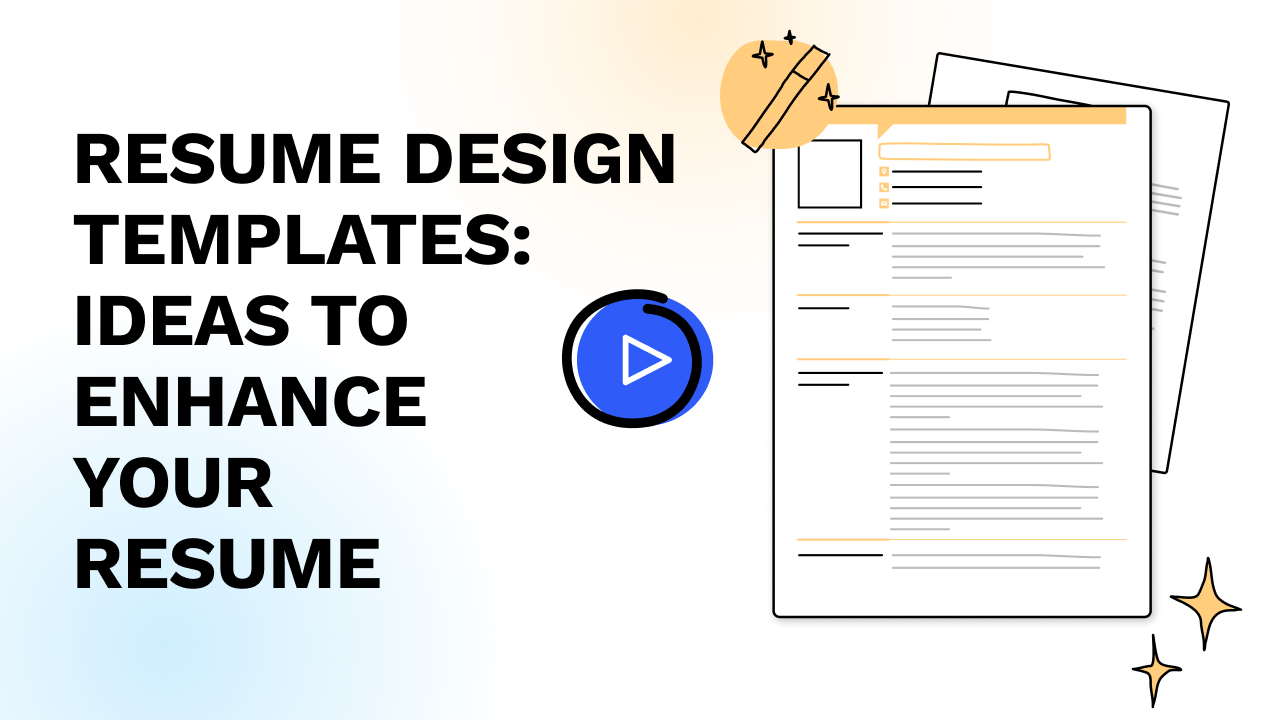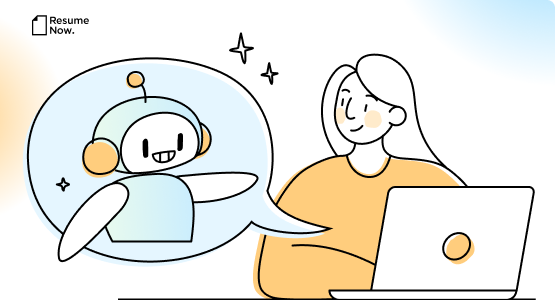A well-designed resume catches the hiring manager’s eye before they even read a word. While great content matters, the design sets the tone, showing you’re professional, polished and prepared.
Conversely, a poorly designed resume can leave the wrong impression and hurt your chances of landing an interview.
However, with our guide, you’ll find:
- Top-notch resume design examples.
- Design ideas for job seekers in every field.
- Easy tips to create a standout resume.

Want a resume design built just for you? Try our AI Resume Builder and get your resume in minutes. With 40+ professional designs to choose from and auto-generated text for every section, creating an impressive resume has never been easier.
15 Resume Design Ideas
The right resume design is all about how the layout complements you and your goals. You want to find the right balance between professionalism and personality so that your resume is neither bland nor tacky.
With that in mind, we’ve collected 15 excellent resume design templates for you to consider. Pick the one that’s best for you!
1. Catch the recruiter’s eye with your header
Want to grab the hiring manager’s attention right out of the gate? Iris is a modern resume template with a strong use of header space. The block of color helps your name stand out and draws the eye to your contact info. This works particularly well with a bold, sans-serif font like Arial.
2. Consider using an insignia
Eyes move from left to right across the top of a page, and some designs use the upper-left corner effectively with a logo, monogram or small insignia based on the candidate’s initials. Sleek and minimal, this design — known as Aspen — uses thin, delicate lines throughout. They’re used most noticeably to break up the candidate’s initials.
3. Showcase your colorful and creative spirit
Resume designs don’t have to be plain. You can make a perfectly professional resume while offering a glimpse of a more playful aspect of your personality, particularly if you work in the arts. This creative resume template does exactly that by including a spotted pattern that appears to be poking its head around the corner. While the design is fun, it doesn’t take away from the content, which remains well-organized.
4. Get clever with the border
Complement your qualifications with a thematic touch. Notice how the color falls outside the borders of this resume? This design can send the message that you think outside the box, which is a common workplace value that many employers seek in their candidates.
5. Go crisp and refined
Bring clarity, precision and excellence to your job search by choosing a design that is crisp and refined. Clear lines and well-structured information make your document easier to read, not to mention employers will be impressed with your organizational skills. The template above, named Crisp, accomplishes a lot with very little. Minimalist templates remains a powerful tool in the resume-building toolbox.
6. Make a statement
Want your resume to stand out while staying professional? This resume design uses a bold contact header, along with graphics around initials, to draw attention. Meanwhile, the rest of the page clearly outlines your most important details. Pair it with a clean font for a polished look.
7. Say hello with this playful spin
A unique, playful design could help you stand out from other candidates, show your personality and encourage recruiters to spend more time with your resume. Take Quote Bubble, for example. This template uses a speech bubble instead of the conventional header, almost as if the candidate is speaking directly to you. There’s also space to add your job title, which isn’t always the case with other resume designs.
7. Establish your presence
The use of a design around your initials in the upper-left corner effectively creates a logo that is sleek and minimal. With a two-column format to organize your qualifications, there’s a lot you can fit on the page without it looking too cluttered.
8. Be strategic with whitespace
With a colorful header and a wide left margin devoted to section titles, this resume design is both modern and easy to navigate. Consider creating a resume like this when you want to place the focus on your work history.
10. Return to a classic
For a simple resume template, you can’t get much better than an old-school design like the Standard. What’s the benefit of paring down your design to the basics? For one, such designs are more likely to be compatible with the applicant tracking systems (ATS) employers use to screen applicants. Plus, they make a professional and serious impression on the reader and, most importantly, are very easy to read.
11. Put your best face forward
Hoping to add a personal touch? Include a headshot on your resume. The Spotlight template does exactly that, conveying confidence and approachability even before the recruiter starts reading. In the U.S., this type of design is best suited for fields in which headshots are the norm, such as acting, modeling, television or public relations.
12. Subtle color goes a long away
Put a stamp on your qualifications with a resume that mixes in color to guide the reader’s attention from your name to your qualifications. Each section provides ample space to list your information in a way that is both engaging and practical.
13. Go big with a unique design element
Another way to add visual interest and showcase creativity is by adding a major design element to a professional resume template. Here, the quotation mark helps block off the header area, serving a specific design purpose. It also shows innovative thinking, which can be an important quality in creative fields. Ultimately, there’s no harm in experimenting with these types of features, but you must use them wisely.
14. Simple yet effective
Sometimes, you just need a basic resume design, especially for traditional industries like law, but that doesn’t mean it should be boring. As this layout shows, you can still organize your information in an elegant manner without any fanfare.
15. Guide the reader down the page
Your resume starts with your contact information at the top of the page, embedded in the banner. Then, a subtle transition in faded colors guides the reader to your name. The surrounding whitespace envelops your qualifications, allowing them to take center stage, with each section clearly labeled.
How to Design a Resume
You’re ready to design your resume. That’s great! Before you get started, there are just a few things you should know about design to make sure your formatting decisions help your chances of landing a job.
Select an appropriate font
To make a great resume, you must choose a proper font. Font is one of the first things a hiring manager notices, and a wacky or poorly designed font can be polarizing. The right font, however, will help bring your design together.
Choose a font that is:
- Professional — Avoid silly, decorative fonts like Jokerman and keep it simple with old standbys like Arial, Calibri and Times New Roman.
- Easy to read — Avoid any fonts that are hard to read.
- Appropriate to your industry — Creative fields like photography and graphic design have more leeway to choose unusual fonts than other, more buttoned-down professions.
You also need to size your resume font correctly. Go between 11-12pt for the regular text and 14-16pt for the section headers.
Pro tip: Open your document in Google Docs and Microsoft Word to ensure your font is universally compatible. Some fonts only work in specific systems, and you don’t want your font to disappear when the employer opens the file.
Set the margins on your resume design
Margins are another critical part of a well-designed resume. Setting proper margins improves readability and ensures everything fits well on the page.
The standard margin size is about 1 inch. You can go as low as half an inch (0.5”) if you’d prefer or need a little more space for your sections.
Ultimately, margins give your resume more white space, making your document more readable and less cramped.
Pro tip: Be consistent. Just as important as sizing the margins correctly is consistency between the margins. You don’t want your top and bottom margins to differ, or everything will look off balance.
Organize your resume into sections
Next, decide which section to include on your resume and organize them in a sensible way. It’s important to give your resume a logical flow to highlight key information in a particular order.
Start by choosing a resume format. The three format types are:
- Chronological resume format — Work history is the most prominent section in this format. Start with your most recent job and work backward.
- Functional resume format — In this format, skills sections take center stage so you can draw attention to your abilities.
- Combination resume format — This format balances the work experience section with the skills section.
Once you’ve chosen a format and covered the basic sections you’d find on any resume, you may want to add more sections to highlight your specific strengths. The most popular additions include foreign language, volunteer work and honors/awards.
Pro tip: Curious to see how different professionals choose to organize their resume sections? Check out our resume examples for a range of options.
Determine the best resume length
How long should your resume be? You’ve probably heard differing opinions on resume length, including the idea that it should only be one page.
The truth is, the length of your resume should support the content. If you’re early in your career and only have one page worth of content, then one page is perfect! If you’re more advanced and have two pages, that’s the ideal!
Two pages is generally considered the maximum length — and for good reason. Hiring managers don’t have all day to read your resume, so the additional content on pages three and four probably won’t get read.
The one exception? If you’re writing a CV. Browse our CV examples to see how these documents look in various professions.
Don’t overuse bullet points
Bullet points are great. They break up blocks of text to make them easier to read and understand, and to stress the hierarchy of information. You’ll see them in the work experience and skills sections on some of the best-designed resumes in the world.
That being said, when everything is bulleted, it is harder to understand which points are truly important. Additionally, having too many bullets take up space and risk making your resume design feel cramped.
Pro tip: Use bullet points in your work history section to highlight your impact in previous roles. Stick to three to four bullets per job to make smarter use of space.
Use color effectively in your resume design
How about adding a bit of color to your resume? There’s nothing wrong with giving your resume a splash of color to make it more vibrant and visually appealing. In fact, some of the most successful resumes have color.
But a little color goes a long way. To use color effectively, you should:
- Stick to conservative colors.
- Make sure the colors look okay when printed in black and white.
- Be consistent by only using one to two colors throughout.
- Choose colors appropriate for your industry.
Pro tip: Subtle colors, like pastel hues or deep blue and green, are best when you don’t know the preferences of your audience. More extreme colors, like neon, risk alienating the viewer.
Download as a PDF
One last consideration — which file format preserves your design best? In general, you’ll have the easiest time with PDFs.
You should read the job post to see whether PDFs are accepted. Ultimately, you need to follow the submission guidelines.
Now you’re equipped to find the perfect ready-made design for you or to make your own design that brings you closer to your dream job.
Was this information about Resume Design Templates: Ideas To Enhance Your Resume helpful? Let us know!
Don is a Certified Professional Resume Writer (CPRW) with more than 10 years’ experience creating digital content, including four years helping job seekers develop their careers. He holds an M.S. in Journalism from Northwestern University.
More resources

What Is a CV? Curriculum Vitae Definition & Who Should Have One
Do you need to know what a CV stands for? We share the definit...

Hard Skills: 70+ Examples to Put on Your Resume
Hard skills are more important than ever in competitive indust...

AI Trends Heading Into 2026: Resume Now’s Year in Review
Across 2025 Resume Now surveyed thousands of workers and empl...

Interview-Winning Culinary Resumes Examples and Tips
Build & download your Culinary resume in a few simple steps. B...

Interview-Winning Cosmetology Resumes Examples and Tips
Build & download your Cosmetology resume in a few simple steps...

Interview-winning Copywriting Resumes Examples and Tips
Build & download your Copywriting resume in a few simple steps...
